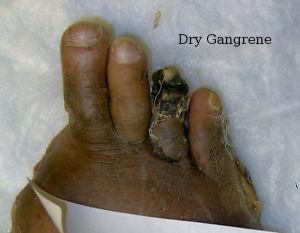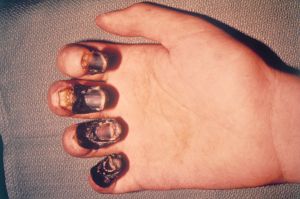Dry gangrene
Background
Gangrene General Info
- A form of tissue necrosis characterized by critically insufficient blood supply leading to tissue death.
- Primarily divided into wet gangrene vs dry gangrene. Other, specific forms of gangrene include Fournier's gangrene, gas gangrene, and necrotizing fasciitis.
- Most commonly occur in distal extremities, clasically the feet.
- Main risk factors are diabetes, smoking, and peripheral arterial disease.
Clinical Features
- Dry gangrene is tissue necrosis often due to chronic progressive ischemia from peripheral arterial disease, but can also be caused by acute limb ischemia.
- Presents with dry, cold, shrunken tissue, usually ranging from dark red to completely black, often with a clear line of demarcation between healthy and necrotic tissue.
- Usually not associated with infection (in contrast to Wet gangrene) as bacteria cannot survive in the dry/mummified tissue; however, development of secondary infection is possible[1]
- Typically not painful due to associated nerve death
- Nonpalpable pulses are common
Differential Diagnosis
Foot infection
- Gout
- PsuedoGout
- Cellulitis
- Gangrene
- Trench foot
- Abscess
- Necrotizing soft tissue infections
- Osteomyelitis
- Diabetic foot infection
- Charcot Foot
Look A-Likes
Evaluation
- History and physical examination are usually sufficient to make the diagnosis.
- Consider ABI or pulse volume recording (PVR) for early evaluation of peripheral arterial disease.
- If acute limb ischemia is suspected, consider a CTA of the affected limb and a vascular surgery consultation.
Management
- Infection rarely present
- <8% of cases convert to wet gangrene [2]
- If has any areas consistent with wet gangrene or surrounding SSTI or Necrotizing fasciitis, treat as for those entities
- Keep area clean and dry to prevent infection; consider debridement
- Early involvement of vascular surgery
- Although revascularization is possible for chronic ischemia, dry gangrene signifies that the tissue is already necrotic
- Amputation is often the treatment of choice for significant necrosis; patients could also await autoamputation, which usually occurs in <6mo [3]
- Diabetes or immunocompromise may warrant lower threshold for consultation [4]
- If acute limb ischemia is present, embolectomy or surgical bypass may be required to restore flow.
- Ensure patient has adequate medical management of predisposing risk factors
Disposition
- Outpatient, if acute limb ischemia is NOT a concern
See Also
External Links
References
- ↑ Buttolph A, Sapra A. Gangrene. [Updated 2023 Aug 7]. In: StatPearls [Internet]. Treasure Island (FL): StatPearls Publishing; 2025 Jan-. Available from: https://www.ncbi.nlm.nih.gov/books/NBK560552/
- ↑ Latz CA et.al. Rates of conversion from dry to wet gangrene following lower extremity revascularization. Ann Vasc Surg. 2022;83:20–25. https://www.sciencedirect.com/science/article/pii/S0890509622000115. doi: 10.1016/j.avsg.2022.01.005.
- ↑ Al Wahbi A. Operative versus non-operative treatment in diabetic dry toe gangrene. Diabetes Metab Syndr. 2019 Mar-Apr;13(2):959-963. doi: 10.1016/j.dsx.2018.12.021. Epub 2018 Dec 27. PMID: 31336551.
- ↑ Rodrigues J, Mitt N. Diabetic Foot and Gangrene. Gangrene - Current Concepts and Management Options. Published online August 29, 2011. doi:https://doi.org/10.5772/23994






